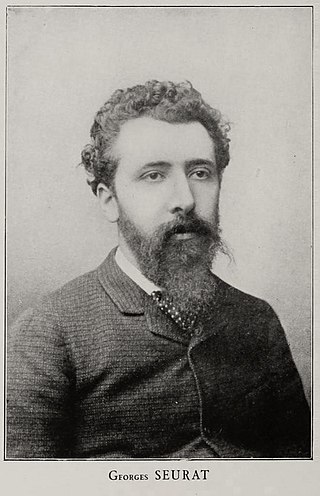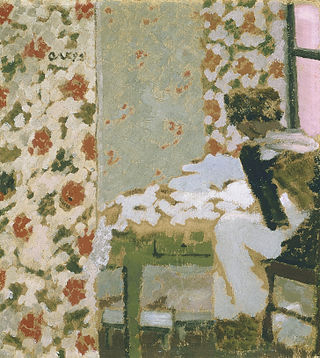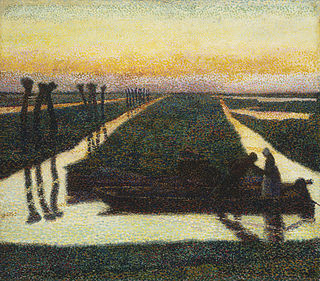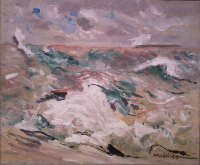
Georges Pierre Seurat was a French post-Impressionist artist. He devised the painting techniques known as chromoluminarism and pointillism and used conté crayon for drawings on paper with a rough surface.

Pointillism is a technique of painting in which small, distinct dots of color are applied in patterns to form an image.

Paul Victor Jules Signac was a French Neo-Impressionist painter who, with Georges Seurat, helped develop the artistic technique Pointillism.

Morning at Grand Manan is an 1878 oil painting by Alfred Thompson Bricher. It is part of the permanent collection at the Indianapolis Museum of Art, and is currently on view in the Paine Early American Painting Gallery.

Reflections is an oil on canvas painting by American artist Arthur Dove from 1935, now in the Indianapolis Museum of Art, in Indianapolis, Indiana, US.

The Love Song is an oil painting by American artist Norman Rockwell, located in the Indianapolis Museum of Art, which is in Indianapolis, Indiana, United States. It originally appeared in the Ladies Home Journal in December 1926. It depicts two elderly musicians, on flute and clarinet, playing a duet while a young girl takes a break from sweeping to listen. The painting's title appears on the sheet music from which the musicians play.

Ma Jolie is an oil on canvas painting by Spanish artist Pablo Picasso, which is located in the Indianapolis Museum of Art, in Indianapolis, Indiana, US. Completed in 1914, its fractured depiction of everyday objects is an example of Cubism. It is not to be confused with the 1912 Picasso of the same name, which is now in the Museum of Modern Art in New York.

Red Kimono on the Roof is an oil painting by American artist John Sloan, located in the Indianapolis Museum of Art, which is in Indianapolis, Indiana, USA. Painted in 1912, its down-to-earth subject matter and execution make it an excellent example of the work of the Ashcan School, which was active in New York City in the early years of the twentieth century.

Vorhor, the Green Wave is one of the most famous paintings by French artist Georges Lacombe. It is currently located in the Indianapolis Museum of Art, which is in Indianapolis, Indiana. Painted 1896-97, Lacombe used egg tempera and the inspiration of Japanese prints to depict the cliffs of Vorhor in Brittany.

The Seamstress is an 1893 oil painting by French artist Édouard Vuillard, located in the Indianapolis Museum of Art, which is in Indianapolis, Indiana. It is a small, intimate image of a woman sewing.

U.S.A. is a trompe-l'œil oil painting by American artist John Haberle from 1889, located in the Indianapolis Museum of Art, which is in Indianapolis, Indiana. It depicts currency and stamps so realistically that Haberle was accused of pasting real money to the canvas.

Broek in Waterland is an 1889 oil painting by Dutch-Indonesian artist Jan Toorop, located in the Indianapolis Museum of Art in Indianapolis, Indiana. It is a pointillist image of the Dutch village of Broek in Waterland at twilight.

The House of the Deaf Woman and the Belfry at Eragny is an 1886 oil painting by French artist Camille Pissarro, located in the Indianapolis Museum of Art, which is in Indianapolis, Indiana. It is a view of Pissarro's neighbor's yard in Eragny, created during his brief period of experimentation with pointillism.

The Banks of the Oise near Pontoise is an 1873 oil painting by French artist Camille Pissarro, located in the Indianapolis Museum of Art, which is in Indianapolis, Indiana. It depicts the river Oise near the market town of Pontoise.

Still Life with a Chinese Porcelain Jar is a 1669 oil painting by Dutch artist Willem Kalf, located in the Indianapolis Museum of Art, which is in Indianapolis, Indiana. It is a sumptuous still life displaying the sort of costly wares that flowed through the Netherlands during its heyday as a trade center.

The Holy Family with Saint John the Baptist is an oil painting by Italian artist Giovanni Francesco Bezzi, also known as Nosadella, located in the Indianapolis Museum of Art, which is in Indianapolis, Indiana. Painted roughly 1550-1560, it depicts Jesus, Mary, Joseph, and John in a powerful, Mannerist style.

Hurricane is a 1944 oil painting by American artist John Marin, located in the Indianapolis Museum of Art, which is in Indianapolis, Indiana. He used quick brushstrokes and thickly daubed paint to depict a turbulent ocean such as he experienced near his summer home in Maine.

Le Chahut is a Neo-Impressionist painting by Georges Seurat, dated 1889–90. It was first exhibited at the 1890 Salon de la Société des Artistes Indépendants in Paris. Chahut became a target of art critics, and was widely discussed among Symbolist critics.
Caroline Marmon Fesler was an American art and music patron, cultural philanthropist, and fine-art collector. Her contributions to the Indianapolis, Indiana, arts community included financial support and gifts of fine art to the Art Association of Indianapolis, in addition to serving as a board member of Herron School of Art (1916–1947) and president of the Art Association of Indianapolis (1941–1947). Fesler was also a patron of the Indianapolis Symphony Orchestra and founded the city's Ensemble Music Society. Her major art collecting interests and acquisitions tended toward Post-Impressionist and modernist paintings, although not exclusively, and included paintings by Georges Braque, Paul Cézanne, Marc Chagall, Henri Matisse, Pablo Picasso, Georgia O'Keeffe, Georges Seurat, and Vincent van Gogh, among others. The Marmon Memorial Collection, which Fesler established in honor of her parents, remains an important part of the Indianapolis Museum of Art's permanent collections.


















